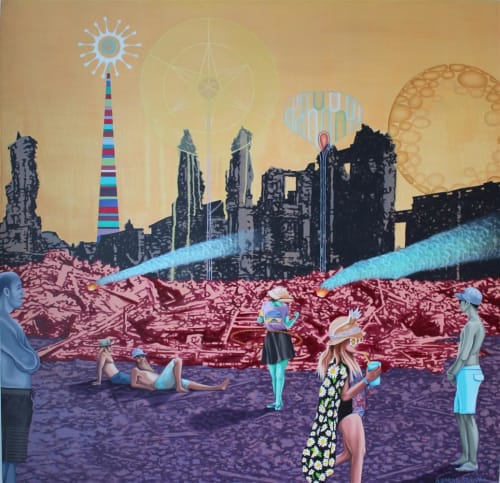The artists in this exhibition each engage with the portraiture medium in various ways and activate its persistent relevance. A genre with a vast history, figuration has been employed by the artists in Portrait as a means to convey their own conceptual concerns – harnessing the human form to stand in for either explicit portrait or generalised entity; self or other.
The viewer becomes the subject of Josephine Cachemaille’s Self Portrait in a Friendly Universe. In her recent studio practice Cachemaille has urged viewers to join her optimistic, animist fantasy – to become more connected, positive beings, traversing modern boundaries between persons and things. In her work for Portrait, Cachemaille evokes a primitive setting within which contemporary concerns can play out – acting as a comical prop, the work coaxes us to touch, prod and investigate ourselves, each other and our relationship with the material world.
Andrew Barns-Graham’s portraits have often referenced the historical treatment of the female ideal in portraiture, presenting flawless female faces painted with hard-edged, anti-gestural style. In his most recent work, while continuing to depict glamorous figures, Barns-Graham has cast a backdrop of colourful dystopia. An element of satire can be perceived within the works, as fashionably-dressed individuals relax and bask in the glow of a dying sun. We are left questioning whether Barns-Graham is making a bleakly humorous comment on popular culture and the cult of perfection.
The subject’s of Megan Campbell’s paintings occupy a decorative and saccharine world that references old medical companions, gardening and floral arrangement manuals from the 1950s. In her most recent work Campbell presents her protagonists pursuing Activities of Daily Living (ADLs). These tasks, often related to self-care, make up the minutiae of everyday life; acts that help to create order and aid engagement with the outside world. Campbell’s paintings are both earthy and ethereal, and are painted with affection for the subject matter with naïve-style.
Wanda Gillespie’s mystical sculptures are carved effigies that challenge historical ideas of the artefact. Using both traditional and current craft techniques, Gillespie’s works are finely detailed likenesses that depict contemporary figures, while still retaining an element of crude construction that acknowledges the constraints of the material. With an interest in the intersection between real and imagined, Gillespie’s 3-dimensional portraits could represent sacred figures from a lost time or culture – perhaps one of her own invention.
Alan Ibell’s work presents enigmatic figures – slight, faceless and even ethereal personages – who occupy washed-out settings and play out inscrutable narratives. With brevity of detail, Ibell’s cast of characters are archetypes who are often caught in pensive, quiet moments that could be taken from half-remembered dreams. His paintings examine the time-old discourse between spirituality, religion and superstition, while challenging the viewer’s preconceived perceptions of reality.
